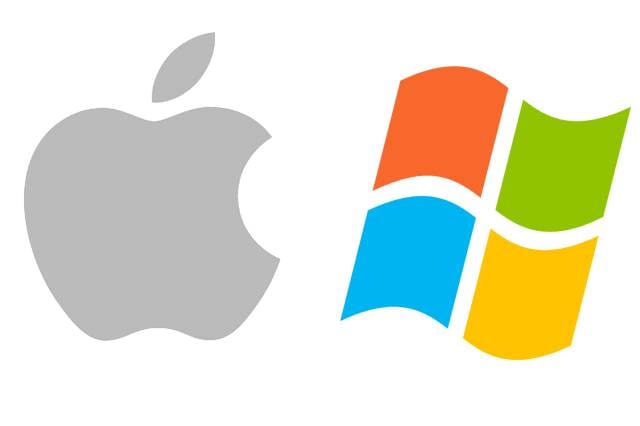Whatever your reason is for jumping from a Mac to a PC, we’re sure it’s a valid one. Perhaps you want a powerful computer at a more affordable price. You could even be making the switch just so you can access the best computer games and productivity suite available today.
While you’re excited to make the switch, you have to think about everything you’re leaving on your Mac. There’s tons of files and software that you will want to keep using even after you switch to a PC. The switch from a Mac to a PC can often be difficult at first and takes some time to get used to. That’s why we created this guide to help walk you through the most important steps when you make the switch.
Setting Up iCloud on Windows
Want to make your photos, documents, music, and all the rest of your files that are on your iCloud accessible on your new PC? Follow these steps to get your iCloud files on Windows:
- Open a web browser and navigate to iCloud for Windows. Click Download.
- Open the downloaded file (icloudsetup.exe), accept the terms of the license agreement, and then click on install.
- When the installation is done, click Finish. Click Yes to restart.
- Click on the newly installed iCloud program. Afterward, enter your Apple ID and password and then select Sign In.
You’re now ready to use iCloud on Windows!
To sync new photos you take on your iPhone with your PC, simply select Options next to Photos in iCloud. You will be able to check and change your photo settings there. Next, select Change and then the Download new photos and videos to my PC option. That’s where you set the folder that your new photos would appear in.
When you want to share the bookmarks you have on iCloud with Windows browsers, select Change and then Bookmarks. Keep in mind, though, that iCloud bookmarks are already synchronized with the Internet Explorer browser. On the next page that appears, select the web browser you want to sync bookmarks with. From there, simply follow the instructions given for setting up the iCloud Bookmarks extension. Once you’re done, your chosen browser will already share bookmarks you had on your Mac and iPhone.
Creating a New Microsoft Account
NOTE: If you own an Xbox, you don’t need to go through all these steps because you most likely have a Microsoft Account already.
Just as OS X requires you to have an Apple ID to access its many services, Windows also needs you to have a Microsoft account to do the same. With your new Microsoft account, you can make Skype calls, buy apps, share files in OneDrive, and work with the Office 365 suite. So when you decide to make the switch, making a new account will be necessary.
- On an Internet browser, go to Microsoft Windows Account page. Click on Create a free Microsoft account.
- Fill in personal credentials and make a password. We’ve got a few tips on how to make a secure password so it won’t be easily guessed by hackers.
- Click on Get a new email address if you want a Microsoft account that is separate from your personal account.
- Select Create account and you should have a Microsoft account by then. Verification is necessary before you can make the most of it, though. To do this, open your email account and select Verify.
Now you’ve got a Microsoft account!
Setting Up iTunes on Windows
No need to throw away years of iTunes purchases just because you jumped from Mac to PC. Luckily, Apple has made iTunes available for Windows users.
- Go to apple.com/itunes on a web browser. Click on the Download button.
- Click Download Now. Open the newly downloaded file (iTunes6464Setup.exe) and click Install. When prompted during the installation process, simply choose Yes.
- After the installation, select Finish. By default, the iTunes program will be opened after.
- Once you’re in iTunes, just select Agree on the software license agreement window.
- On the next window, tap on either No Thanks or Agree. Afterward, look for the Account icon with a dropdown option beside it.
- Input your Apple ID and password and click Sign In
Your Windows PC will now have ready access to all your iTunes purchases.
Moving Your Mac files to Windows
A major obstacle you’ll face when making the switch is bringing over all your files. When you’ve already upgraded to Windows 10, the OS will require you to store movies, music, documents, and photos in specific folders in the same way that your Mac does. Simply follow the procedures below so Microsoft’s Photos app will recognize your images, its Groove Music app will import your playlist, and all your files will be right where they should be.
Before you proceed, remember to use an external hard drive that’s compatible with PCs and Macs. Doing so will require you to format a drive, which we’ll tell you in detail below. First, though, let’s begin with preparing to move your photo albums.
- Connect your external drive to your Mac. Afterward, open the drive and click on File.
- Select New Folder and then name it “Exported Files”. Hit Return right after.
- Open the Photos app. Click Edit > Select All from the menu bar.
- Click File once more > hover over Export > Export Unmodified Original For…
- On the succeeding screen, click on the drop-down button next to Subfolder Format > select Moment Name. Click on Export button.
- Click on your external hard drive, select the “Exported Files” directory, and then click on New Folder near the bottom-left corner of the screen.
- Type “Photos” and select Create. Next, click on Export Originals button.
Keep in mind that this may take a while to finish, depending on how many images you’re exporting.
While waiting for it to be done, let’s proceed with preparing to export your iTunes playlist.
- Open iTunes and once you’re in, right-click on any song. Scroll down and select Show in Finder option.
- Press the keys Command + Up three times to move up to Artist directory > Music directory > iTunes Music directory.
- Click and drag the Music folder icon to your external hard shown in the side menu. Hold the mouse button down until you’re shown the contents of the external hard drive.
- While still holding down the mouse button, move the Music folder to the Exported Files folder you made earlier and release the mouse button.
Your music playlist should begin to copy, but it may take some time. Again, this depends on how extensive your music library is.
Now, let’s begin creating a copy of the remaining important files and folders on your Mac.
- Click Go > Home in the menu bar.
- While pressing the Command key, click on Desktop, Downloads, Movies, Documents, and any other directories you wish to bring to your new Windows home.
- Again, drag these folders to the external hard drive shown in the side menu. Hold down the mouse button until the window shows the contents of your external drive.
- Move the folders to the Exported Files folder before releasing the mouse button. Once more, you’ll have to wait until the progress bars disappear. That will mean the files and folders have already been moved.
Now, you’re all set to move your files from your Mac to your PC! Of course, don’t forget to click the Eject button shown beside the external hard drive’s icon before unplugging it from your computer.
Finally, we move to the final phase of the operation: copying your files on Windows.
- Connect the external drive to your PC. Afterward, click on the File Explorer icon found on the Menu bar.
- Double-click the external drive > Exported Files folder > Desktop folder.
- Go to the Home drop-down menu found on top of the window and look for Select all button.
- Drag all the files to the Desktop icon found in the side bar. Do the same for every folder you have in the external drive, though try to match the folder with the appropriate destination.
Your Windows PC will now have all your Mac files after all these.
Formatting a Hard Drive That Works with Mac and Windows
To move the files from your Mac to your PC, you need an external hard drive that is compatible with both operating systems. To make one that works with MacOS X and Windows 10, you need to format the drive into using the exFAT filesystem.
We’re suggesting exFAT over the usual FAT32 file system for a couple of reasons. Sure, the FAT32 format can be read by both OS but exFAT has a much larger file size limit compared to the former. Not to mention that it performs better, too.
- Connect the external hard drive to your Mac.
- Press the keys CMD + spacebar and type “Disk Utility” to find and open the said program.
- Select the drive you wish to format > click the Erase button up top.
- Give the partition a name. Afterward, select exFAT as the format.
- Click Erase.
You now have an external drive that you can plug into both your Mac and Windows machine anytime. Take note, though, that frequently jumping on either computer increases the risk of corrupting your files so prepare backups beforehand. Note: We’ve got tips on that, too!
Converting Mac Files to Work on Windows
Not all Apple files are readable on a Windows PC. That’s why you have to copy and paste text from Apple’s Notes app and download iTunes for Windows. Files from Apple’s productivity suite along with your address book contacts can be converted to a Windows-friendly file. We’ll teach you how to convert files from Numbers, Pages, Keynote, and Address Book after the jump.
Convert Numbers files into Excel documents
- On a Windows browser, navigate to iCloud.com. Sign in with your Apple ID.
- Click on the Numbers logo, then click the Gear icon.
- Click on Upload Spreadsheet… option and then choose a Numbers file to open.
- Once the Numbers file has been uploaded, right-click on the file.
- Select Download a Copy… option and then choose Excel as its download format.
Convert Pages files into Word documents
- On a Windows web browser, sign into iCloud.com with your Apple ID and password.
- Tap the Pages icon and click on the Gear icon.
- Select Upload Document… then choose a Pages file in the succeeding window. Click the Open button.
- Right-click on the newly uploaded Pages file and select Download a Copy… option.
- Select Word as the download format and your Page file will now be in a Microsoft Word format!
Convert Keynote files into PowerPoint format
- Go to iCloud.com on a Windows browser and log in using your Apple ID.
- Choose the Keynote logo. Click on the Gear icon afterward.
- Tap on Select Upload Presentation… option and choose a Keynote file to upload. Click the Open button.
- After the Keynote file gets uploaded, right-click on it and select Download a Copy… option.
- Choose PowerPoint as the download format and your Keynote presentation will be converted into a PowerPoint document!
Convert Address Book files for Windows
- Open your Mac’s Contacts app and select all the contacts you want to transfer to your Windows PC. Press keys CMD + A to select all to choose every contact on your list faster.
- Right-click on the selected contacts and choose Export vCard… option. Click on Save button.
In no time, all your contacts can be exported to your PC using the widely supported .vcf file format.
With these tutorials, you may be better poised to make the ultimate switch between two popular operating systems. If you’re more technology-savvy, you should network your Mac and PC since it’s much faster that way. If you’re just an average user, however, our tips should get you and your files ready to make the jump.
Is there anything else about moving to Mac to PC that you wish to know about? Don’t hesitate to drop us a comment below and we’ll get you the answers you need ASAP. Until then, we wish you the best of luck on your new Windows home!


